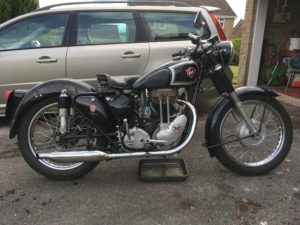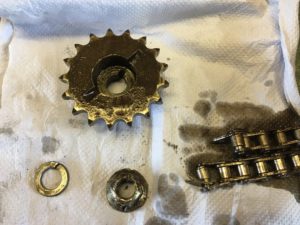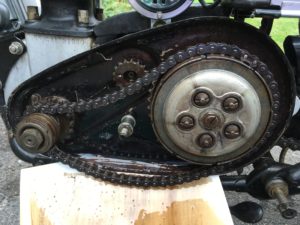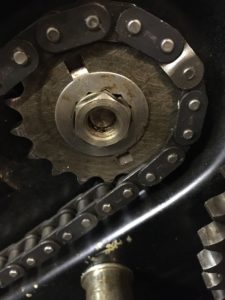Unbeknown to me, there was a problem that had been lurking for about fifteen years, just waiting for its chance to bite. I’d left home on a sunny afternoon with the intention of heading up to Bellingham for coffee and cake at Rocky Road, then returning home. It’s a distance of around forty miles in a sort of loop; a great ride for a vintage bike…or any other bike for that matter.
Here’s a picture of the bike ready to go, complete with original drip tray…ha ha.
About a mile west of the Stagshaw Roundabout and the Errington Coffee House, the bike started behaving strangely. There was no change to the engine note, nor any mechanical noises, but it felt like the engine was suddenly losing about 25% of its power then soon after getting it back again. This happened a few times and I pulled over. There didn’t seem to be a problem but I turned round and headed slowly home…thankfully it was downhill but I still need a little drive from the engine.
All seemed well…then I turned right down the A68 towards Corbridge. After half a mile there was a horrible noise from the primary chaincase and the rear wheel almost locked up. I was at the side of the road anyway so pulled the bike onto the verge. The rear wheel was almost impossible to turn and the chain was dead tight. Recovery was the only option… my insurers Carole Nash said it could be up to two hours so I called Glendinning’s in Prudhoe and they came straight out.
To say I was ‘crestfallen’ is an understatement…I just knew the damage was going to be extensive.
On Matchless motorcycles with a separate dynamo, they are driven by sprockets and a chain from the crankshaft, via a shock absorber. If the chain is slack, snaps or something happens to the dynamo sprocket, many bad things can happen. In the case of my bike, the dynamo sprocket was held on by a standard split washer and a nut. The woodruff key (absolutely essential) was missing too. Much of the dynamo was original and I suspected it had somehow been loading the engine, causing the apparent loss of power, which eventually caused the dynamo sprocket to spin, the nut to loosen and …disaster. At this point I’ll mention that much later I felt that the dynamo sprocket issue may be an unlucky coincidence, and that the problem lay elsewhere.
The dynamo nut is supposed to be secured with a woodruff key on the tapered dynamo shaft, then a special locking washer, nut and circlip. Some people only use their bikes during daylight so remove the dynamo and hope the battery, which they charge regularly, will be enough if they get caught out in the dark. Others have converted to belt drive. Matchless sold many thousands of bikes…if fitted properly, their dynamo sprocket arrangement should be reliable.
I took the primary chaincase cover off to examine the damage. The dynamo nut had come off, the sprocket was hanging on the end of a bent dynamo shaft, the dynamo chain was snapped and wedged in the bottom of the chaincase. There was more…the primary chain had half jumped off the sprockets, splintering pieces of metal off the engine sprocket and making superficial marks on the clutch housing. Because it was so tight, it had pulled the gearbox forward making the rear chain tight as a drum too. I managed to dislodge the primary chain at which point the tension was released everywhere. The primary chain was also damaged beyond reuse. There was still more…when I turned the gearbox using the kickstart, they was a ticking noise coming from the box and the gear indicator was moving in and out in time with the ticks, about 3/16 of an inch.
It looked like a had a full strip and rebuild of the gearbox ahead of me as the gear indicator should not do this.
The engine drive sprocket was easily obtained as were new chains. Some of the other parts were sourced from further afield. The next jobs were sorting out the dynamo and gearbox.
Before you go to the next page, this is what the correct locknut assembly for the dynamo sprocket looks like. There’s a woodruff key to stop the sprocket turning, which is held on with a special nut that has a ‘washer’ fit over its sides, which locks into two slots on the sprocket to stop the nut undoing, the washer being held in place by a circlip in a slot on the nut.



